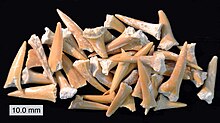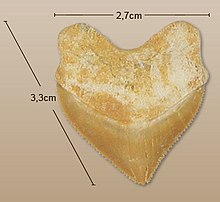Fossil shark tooth
Fossil shark teeth are - besides vertebrae - usually the only remaining fossils of extinct sharks . Since sharks produce a large number of teeth because of their revolver teeth, these are among the most frequently found fossils.
Historical names for fossil shark teeth are adder tongues, otter tongues, serpent tongues, bird tongues, tongue stones, dragon teeth, glossopetres, ophioglossa, stone tongues, snake stones and thunder stones .
Research and Use
As early as 1616, Fabio Colonna was able to show in his essay De Glossopetris Dissertatio that the supposed viper tongues are in fact shark teeth. But even beyond the end of the 17th century, the pointed or triangular fossils, from light to blackish-gray in color, were mostly thought to be natural games ( Lusus naturae ), petrified snake tongues or the teeth of dragons. Even Conrad Gessner and Guillaume Rondelet noticed the similarity of ophioglossum and the teeth of today's sharks. With Nicolaus Stenos' publication Canis carchariae dissectum caput , published in 1667, this knowledge became generally accepted.
The amulet function of the adder tongues has been reported since the 13th century. In the Middle Ages, they were used as protection against malicious gossip. They were also used as a poison test because they were said to be sweating on poisoned food. They were used individually, hung in groups from coral adder tongue trunks or trees or attached to drinking vessels or their lids.
Locations and species
Locations are known all over the world, the most important are in Morocco , Florida and in the Atacama Desert in Chile . Another well-known site for fossil shark and ray teeth is Cadzand , a place in the extreme southwest of the Netherlands. In Morocco, shark teeth between 3 and 70 million years old are being excavated in Khouribga near the “Plateau des Phosphates”. They got their color from the minerals that permeated them.
Primeval shark species
Squalicorax pristodontus (locality: Agassiz, 1843) had flat, triangular teeth up to three centimeters long. As with the tiger shark today, the cutting edges werefinely serrated. In the Cretaceous Period , the genus Squalicorax was widespread worldwide. In America, Africa, Japan, Australia, India, Russia, the Middle East, and Europe, fossilized teeth have been found in the sediments of the Mesozoic Era.
Megalodon ( Carcharocles megalodon ) lived in the Cenozoic and had the largest teeth of all sharks ever living, which are highly sought after by collectors.
literature
- Yvette Gayrard-Valy: Fossils: Witnesses of primeval times (transl.) Maier, Ravensburg 1991, ISBN 3-473-51015-7
- Eugen von Philippovich: Adder tongues. In: Curiosities / Antiques. Klinkhardt & Biermann, Braunschweig 1966
- Adder tongues and adder tongues sideboard . In: The large art dictionary by PW Hartmann. Hartmann, Sersheim 1997, ISBN 3-9500612-0-7
- Stephan Molitor, viper tongues in the silver treasure. To strange cimelas in Count Eberhards III's legacy inventory. of Württemberg († 1417) and its interpretation (with edition). In: The Visconti and the German Southwest. Cultural Transfer in the Late Middle Ages, ed. by Peter Rückert and Sönke Lorenz (= Tübingen building blocks for regional history 11). Ostfildern, Jan Thorbecke Verlag, 2008, pp. 317–333. ISBN 978-3-7995-5511-1



